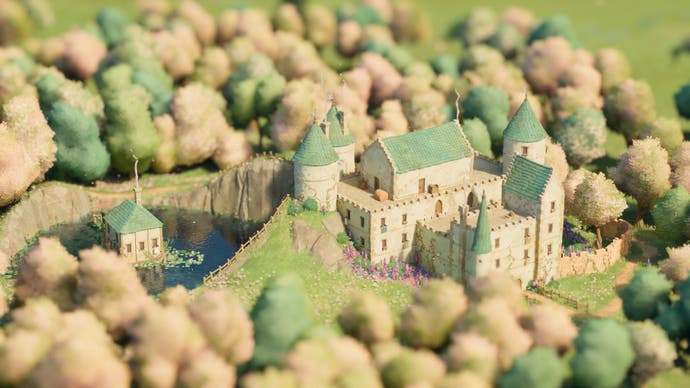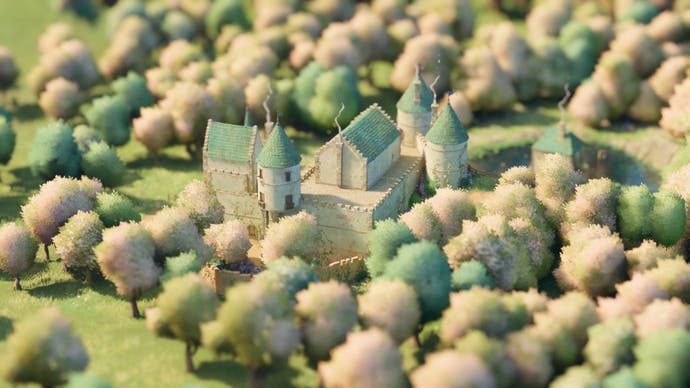Tiny Glade: an indie diorama builder that proves the power of bespoke game engines
Beautiful ray-traced visuals at 60fps... on a GTX 1060?
Tiny Glade is the sort of indie game we love to be surprised by at Digital Foundry: one that uses seriously impressive custom tech to create something unique. Made by just a two person team, developer Pounce Light has crafted a simple and charming gameplay loop: make, create, and arrange castles, villas, or cottages to your liking using the game's flexible building system. It may be cozycore on the surface, but there's plenty of bespoke stuff driving its warm pastel aesthetic, including ray-traced global illumination (RTGI), ray-traced reflections and loads of procedural tech. Impressively, it all runs really well on near-decade-old GPUs too. RT on a GTX 1060? Believe it.
This is a game which has surprised me with nearly every aspect of its technical execution and that starts right away with the user experience. As its name suggests, this is a tiny (1.8GB) game that can live entirely within active RAM and as a result it's ultra-snappy. You reach the first screen two seconds after launching it on Steam, and six seconds later you can be playing. Even games running on cartridge sometimes take longer to start! The game's use of proceduralism also means that all loads are fast, with starting a new scenario taking less than a second, so you can near-instantly be creating something different.
Of course, Tiny Glade isn't throwing about 4096x4096 textures everywhere to slow it down like a AAA game, but we don't expect such a snappy experience even from modern indie titles. That's enhanced by the highly polished user interface and 3D camera, which react quickly to your input - important elements for mouse-driven games like RTS and city builders.
There's some beautiful attention to detail here - like the inertia and rhythm you feel as the camera whips around, or the way buildings morph and align to the environment as they change size, with vines growing up buildings and bird houses or barrels appearing alongside walls. The buildings themselves have their controls built in diagetically, allowing you to change their width, height, rotation and styling without moving to a distant part of the UI. There's a lot of procedural detail, and a lot of joy in seeing how objects that you place automatically change to fit their surroundings in funny or surprising ways.
The rendering tech is another stand-out feature of this little game. The game uses a Vulkan renderer with zero shader compilation stutter and makes extensive usage of compute shaders to drive the rendering. Tiny Glade's diffuse global illumination uses software ray tracing, so it scales down to ultra low-end and older GPUs. According to the developer, the game traces against lower complexity proxy geometry and shots rays at sub-native resolution, with one ray for every 4x4 pixel grid. Like a lot of games using RTGI, such as Metro Exodus Enhanced Edition and Avatar: Frontiers of Pandora, rays first start in screen space, and then move out of screen space to trace against the proxy geometry in a BVH only when they need to. This further reduces costs and gives the game extra detail in the lighting in areas within screen space. To keep noise down, the lighting is encoded into a spherical harmonic to smooth things out and is simply denoised as a post process. Essentially, every part of the RTGI is just at the threshold of the quality necessary to fit the art style, which keeps performance up.
For specularity or reflections, RT is also used, but this shows up more seldomly in game, primarily on surfaces of water or ice. There, rays are traced into the proxy geometry again, but notably blended over with screen-space reflections. So if you move the camera up and down while using a camera closer to the ground (like in the game Teardown) you can see how most of the colour and detail from reflections is culled out of screen space and you see the lumpier proxy geometry instead. That does not stop the reflections from being handsome for what they are, but there are clearer visual limitations there than with the diffuse global illumination, which can be a lot coarser in detail before it starts to fall apart.
The global illumination technology gives the game its warm sheen, where objects are joined by light bouncing between them. Like any game with RTGI, you can see some spectacular effects, like the encroaching darkness between the trees in a densely forested area, or the shadows and lighting coming from the sky, allowing areas outside of direct sunlight to look naturally lit and not glowing or out of place. I feel that the RTGI is the gel that holds the visuals together, and it genuinely looks splendid almost everywhere.
The game does possess a few graphical limitations though, such as in indoor areas when you use the "on foot" camera. Here, perhaps due to proxy geometry and a reliance on screen-space rays, you can find areas with disappearing lighting or occlusion issues. Likewise, you can occasionally see bounce light from the sun under the terrain, which affects the lighting of the buildings above when the sun is just below the horizon. But broadly speaking, things look just right, and the corners cut for performance reasons don't disturb the game's visuals.
Beyond the tracing of rays, there are two other effects I want to highlight. The first is the ice rendering, which includes a surface sheen from the sun, reflections and local lights on its top layer. Below this there is layer that shows cumulative darkening and refraction for fish and other objects in the water below. Lastly, you can even see self-shadowing from the cracks in the ice as they disrupt the light passing through them. This makes for a very convincing stylised rendition of ice.


The second effect is the camera depth of field, which I used throughout but can be turned off in the menu if desired. This is the smoothest depth of field effect I've seen in a video game, whether you're looking from a distant tilt-shift perspective or closer in normal gameplay. I'm particularly fond of the depth of field fall-off for near-camera objects against objects in focus behind them. Usually thin objects like sticks in a fence have some discontuity when they overlap things in the background in video games, but that's not the case here. The area of defocus looks natural, with no strange artefacts. This helps the game look physically grounded and at times makes it looks like you're really seeing a diorama - uncanny and gorgeous.
Despite the strengths of these techniques, the game is still a rock-solid 60fps even on low-end hardware. For example, the classic GTX 1060 can run at 80 percent of 1080p - complete with RTGI and reflections. Of course, on high-end GPUs you get an even nicer presentation - I opted for a 6K recording at 60fps for my b-roll shots on an RTX 4090 PC, as seen in the video embedded above. I did note that the game doesn't play well with utilities like RTX HDR and RTSS, both of which caused the game to drop frames even though it was running fine internally.
Regardless of the small issues, there's a huge amount to be proud of here for the two-person development team, with great performance and sound technical decisions that further Tiny Glade's art and playstyle. I think this game also goes to show that RT and high-tech rendering is not just for the AAA space or genres that chase photo-realism. It also ably demonstrates the power of custom technology and why bespoke engines are still needed in our day and age. I can't imagine an Unreal Engine game running this fast or this well without a tonne of work.
With this release as a starting point for the studio, I'm also curious to see where the developers take the title next. I can imagine more palettes, archetypes and increased map sizes in the future, but what's already here is exceptional and well worth trying - and if the inexpensive asking price is still too much for you, a free demo is also available on Steam.


